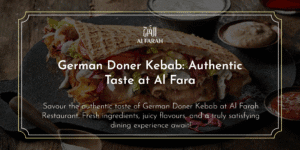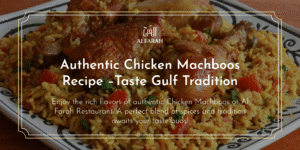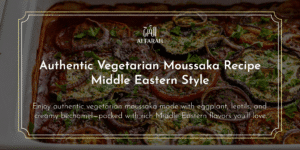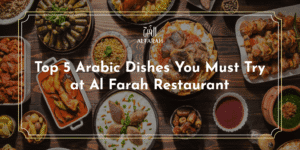Kebab Halabi: Introduction
With the combination of golden yellow sesame seeds crushed into a fine paste, Kebab Halabi can be considered a true gem of the Syrian cuisine. Well-known for its juicy taste and the scent of diverse spices, it has become an inherent part of Middle Eastern food trends. However, it might be asked which factor makes this kebab variant different and unique. Let us start with this culinary adventure to find out a brief history of this dish along with the list of ingredients, as well as the peculiarities of how it is prepared.
History of Kebab Halabi
Origins in Aleppo, Syria
Kebab Halabi comes from the town of Halab –modern Aleppo- a city that was once the cradle of trade, wealth, art and literature in the Middle East. The favourable geographical location of Aleppo at the crossroads of several trade routes, known as the Silk Road, also played an important role in shaping the evolution of this fare.
Historical Influences
These include several discoveries and assimilation of the recipe by different cultures such as Ottoman, Persian and Arabian cultures. It has progressed into various cuisines, preparation techniques and ingredients through these interplays.
Modern Times
Today, like today this dish is considered not only a traditional Syrian dish but also Middle Eastern dishes served in different restaurants. Thus, it can satisfy the postmodernists’ desire for the novel and the unknown while maintaining its main qualities and popularity.
Ingredients for Kebab Halabi
Essential Meats
However, the material essence of Kebab Halabi is the meat part, which distinguishes it from other kebab types. herder’s dish used to be made of a combination of lamb and beef to achieve the best of both worlds as far as tenderness and flavor go. Regarding texture, the meat is minced very well so that it amalgamates well with other ingredients subsequently added to the mixture.
Key Spices and Herbs
One thing about this dish that makes it different is that I used aromatic spices. The combination could be mostly Aleppo pepper with a touch of cumin and coriander, and a sprinkling of fresh parsley and mint. These spices produce a distinct and enchanting aroma that complements the food being prepared.
Other Vital Ingredients
Onions and garlic are then required in the preparation who help to thicken the meat while bulgur wheat can also be incorporated into the mixture. Olive oil is commonly applied to some vegetables and meat to keep it moist and tender all through the cooking.
Preparation Techniques
Traditional Methods
I once read that during the preparation of Kebab Halabi, the whole process of mixing meat with spices and herbs is done manually, so that it becomes evenly distributed. The paste is then spread over the skewered meat and the primary ingredients are allowed to settle for several hours to tenderize and intensify flavor uptake.
Modern Approaches
In the contaminated instances, it can alter it to achieve a better grind using food processors that it might not have been possible in the past or add new components as chili flakes to make it hot. These adaptations retain the dish’s core identity while simultaneously making it more palatable to the modern-day public.
Cooking Tips
To avoid making the mixture too dry one can add a little fat to make it juicy. If you shaped your kebab, it should rest for a few minutes to firm up allowing it not to crumble when grilling.
Cooking Methods
Grilling vs. Baking
Nevertheless, there is no reason why using the charcoal grill as the base method of cooking can be completely replaced by baking. On the one hand, grilling gives meals this amazing smoky taste you probably won’t get cooking or baking elsewhere, on the other hand, baking makes the meals cook evenly.
Using Charcoal for Authentic Flavor
Charcoal grilling is preferred for incorporating a distinct smoky flavor that enhances the kebabs, as in the originals; Middle Eastern street food kebabs.
Alternative Cooking Techniques
However, if grilling and baking practices cannot be done, it is also advisable to pan-fry kebabs can be done in a short time. However, what is necessary is to maintain the heat at a medium level to avoid overcooking the meat.
Variations of Kebab Halabi

Classic Kebab Halabi
Several initial options are starting with the original which has the regular blend of lamb and beef, with the house spices-aleppo spice blend.
Stuffed Kebab Halabi
Stuffed kebabs with something like cheese or nuts are also a good change and more palatable because they add an extra issue to the kebab.
Vegetarian Alternatives
The choice of the main ingredient is rather simple in this case – chickpeas or lentils for the Vegetarian Kebab Halabi. The same spices serve the purpose of maintaining the taste required by the dish throughout the time required in preparation.
Serving Suggestions
Traditional Sides
Pico de gallo accompanies this dish well, along with warm flatbreads, hummus, and other freshly prepared dips and side dishes of tomatoes, cucumbers, and onions. The inclusiveness of pickled vegetables effectively complements the pairing of bold Abyssinian spices with succulent meats served on kebabs.
Modern Pairings
These may include preparing kebabs as a milder menu that can be accompanied by quinoa or couscous, and a side of roasted vegetables if the customer desires a health-conscious meal.
Presentation Tips
For better presentation arrange the kebabs on a colorful bedspread and top with a few pomegranates, fresh herbs and lemon wedges.
Nutritional Information
Health Benefits
Loaded with proteins and other essential vitamins, the Kebab Halabi is a delicacy that would surely not harm your diet. Including fresh herbs and spices also means adding antioxidants to the food that we eat.
Caloric Breakdown
The information in this document reveals that a serving of the food normally offers about 200 – 300 calories depending on the recipe and style of preparation. While cooking meat, people should avoid using fattier cuts since the energy value will then be higher.
Nutrition tips for a healthy meal plan
For a healthier variant, the following changes may be considered: instead of lamb and beef go for ground turkey or ground chicken. : it is also proved that the fat content can be lowered if the products are baked rather than fried.
Cultural Significance
In Syrian Culture
This dish in particular carries deep significance in Syria and isn’t only about the food. It is traditional to have it, particularly during gatherings such as family functions, meals, and festivities in Syrians society.
Celebratory Occasions
In particular, the Kebab Halabi is usually served during weddings, festivals, and other religious functions for it represents an embodiment of the distinctive Levantine cuisine.
Global Influence and Popularity
It has successfully penetrated many nations, and Middle Eastern restaurants are found practically in every country that offers this delicious meal. Indeed lively it is! It is liberally spicy and sweet, liked by everyone.
Pairing Kebab Halabi with Drinks
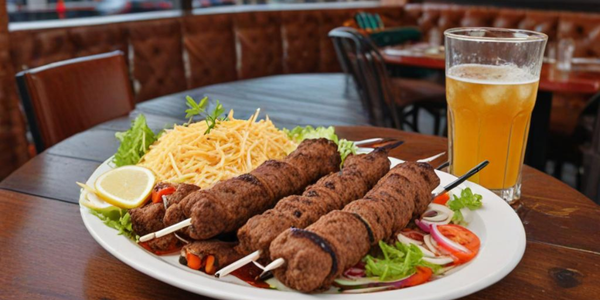
Traditional Beverage Pairings
Ayran, a yogurt-based drink, is a classic pairing, balancing the spices with its cool, creamy texture. Mint tea is another traditional choice, refreshing the palate between bites.
Modern Drink Suggestions
For a contemporary twist, consider pairing it with a light, fruity white wine or a crisp lager. These drinks complement the rich flavors without overpowering them.
Tips for a Perfect Culinary Experience
When pairing drinks, aim for balance. The drink should complement and enhance the flavors of the kebabs, creating a harmonious dining experience.
Recipes to Try at Home
Classic Recipe
Ingredients:
- 500g ground lamb
- 500g ground beef
- 1 onion, finely chopped
- 2 cloves garlic, minced
- 1 tablespoon Aleppo pepper
- 1 teaspoon ground cumin
- 1 teaspoon ground coriander
- 1/4 cup fresh parsley, chopped
- Salt and pepper to taste
Instructions:
- Combine all ingredients in a large bowl.
- Mix thoroughly until well combined.
- Shape the mixture onto skewers.
- Grill over medium-high heat for 8-10 minutes, turning occasionally.
Quick and Easy Version
For a faster version, use pre-ground spices and skip the marinating step. This version can be ready in under 30 minutes, perfect for a weeknight dinner.
Chef’s Special
For an elevated version, stuff the kebabs with a mixture of feta cheese and pine nuts. The creamy cheese and crunchy nuts add an unexpected but delightful twist.
Tips for Buying Ingredients
Selecting Quality Meat
Choose fresh, high-quality meat for the best results. Look for meat with a good balance of fat to ensure the kebabs stay moist during cooking.
Finding Authentic Spices
For the most authentic flavor, seek out spices from Middle Eastern markets. Freshly ground spices will provide the most potent flavor.
Best Places to Shop
Specialty grocery stores, farmers’ markets, and online retailers are great places to find the freshest ingredients for your kebabs.
Common Mistakes to Avoid
Overcooking the Meat
Overcooking can dry out the kebabs. Keep an eye on them and remove them from heat as soon as they are done.
Using Incorrect Spices
Stick to the traditional spice blend for the most authentic taste. Experimenting is fine, but for the first try, follow the classic recipe.
Skipping Marination
Marinating allows the flavors to meld and penetrate the meat. Don’t skip this step if you want truly flavorful kebabs.
Kebab Halabi Around the World
In Different Countries
However, despite the peculiarity, each country has its local version of the burger, with slightly differing ingredients, but still consistent with their basic ingredients list. For example, in Turkey, it is hotter and in some other countries like Lebanon, they add more herbs to the food.
Fusion Recipes
Some variants of this dish are still made using this method, but their ingredient base is merged with the traditional Middle Eastern ingredients combined with cuisines from different parts of the world.
Famous Restaurants Serving Kebab Halabi
Many renowned Middle Eastern restaurants feature this dish on their menus. Al Farah Restaurant offers unique variations that showcase the chef’s personal touch. Al Farah Restaurant includes this dish in its catalog. Some even present some extra diversity which can reveal the individuality of the culinary master.
Kebab Halabi: A Culinary Journey at Al Farah Restaurant
Kebab Halabi is not just a dish; it is a discovery of the culinary heritage of Syrian cuisine. From its origin in the quarter of Aleppo to its widespread popularity across the world, it exemplifies tradition incorporated into contemporary trends. When you savor Kebab Halabi at Al Farah Restaurant, you experience an authentic culinary adventure that is truly phenomenal. Our chefs use traditional recipes and fresh ingredients to bring you the best of Middle Eastern cuisine. And what is there stopping you from inviting some guests over to your home and cooking for them this legendary dish, inspired by the flavors of Al Farah Restaurant? Visit us to taste the tradition and then recreate it in your kitchen! Try Restaurant Network to Buy & Sell used restaurant equipment.




